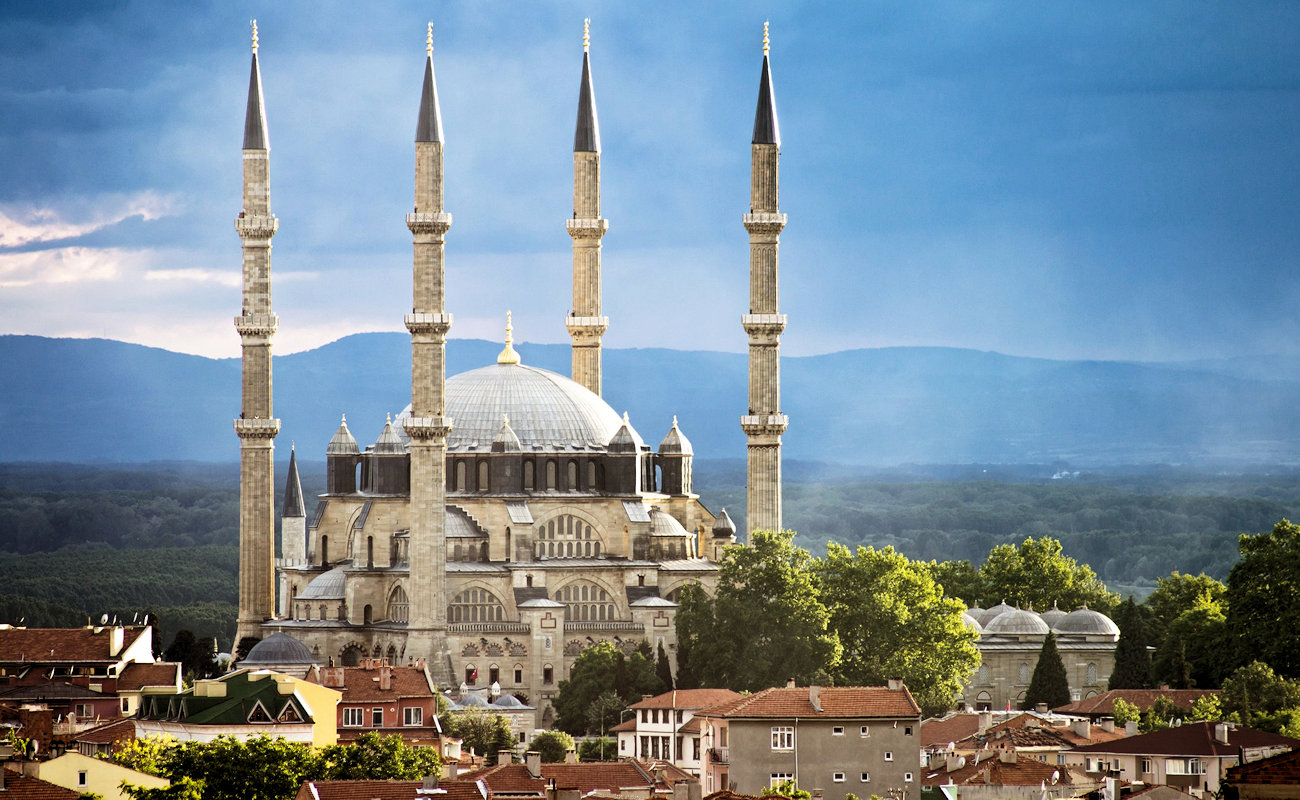
Ottoman Architecture
Ottoman architecture is a style or tradition of architecture that developed under the Ottoman Empire for an extended period. It underwent significant changes throughout its history. The style first emerged in northwestern Anatolia in the late 13th century and evolved from earlier Seljuk Turkish architecture. It was influenced by Byzantine, Iranian architectural traditions and other styles in the Middle East. Multiple building types were experimented with in early Ottoman architecture over the 13th to 15th centuries before progressively evolving into the classical Ottoman style of the 16th and 17th centuries.
This architectural style emerged from a blend of Turkish indigenous customs and inspirations drawn from the Hagia Sophia, giving rise to mosque structures of great magnitude centered on a high central dome and a varying number of semi-domes. Great Architect Sinan is recognised as the principal architect of the classical period. His significant works include the Şehzade Mosque, Suleymaniye Mosque, and Selimiye Mosque. Additionally, in the latter half of the 16th century, there was a peak in certain decorative arts, specifically the use of Iznik tiles. From the 18th century, Ottoman architecture was receptive to external influences, especially Baroque architecture in Western Europe.
His significant works include the Şehzade Mosque, Suleymaniye Mosque, and Selimiye Mosque. Additionally, in the latter half of the 16th century, there was a peak in certain decorative arts, specifically the use of Iznik tiles. From the 18th century, Ottoman architecture was receptive to external influences, especially Baroque architecture in Western Europe.
His significant works include the Şehzade Mosque, Suleymaniye Mosque, and Selimiye Mosque. Additionally, in the latter half of the 16th century, there was a peak in certain decorative arts, specifically the use of Iznik tiles. From the 18th century, Ottoman architecture was receptive to external influences, especially Baroque architecture in Western Europe. During the Tulip Period, a shift in style occurred, which was subsequently followed by the emergence of Ottoman Baroque style in the 1740s.
One of the most crucial examples of this period is the Nuruosmaniye Mosque. In the 19th century, more influences were imported from Western Europe, and architects such as those from the Balyan family played a significant role in this trend. The period of Empire style and Neoclassical motifs saw the emergence of a trend towards eclecticism, as evidenced by many building styles, including the Dolmabaçe Palace. In the latter stages of the Ottoman Empire, a new architectural style came into existence, known as neo-Ottoman or Ottoman revivalism, also referred to as the First National Architectural Movement, created by architects Mimar Kemaleddin and Vedat Tek.
Ottoman dynastic sponsorship was centred in the historic capitals of Bursa, Edirne, and Istanbul (Constantinople), as well as in various other significant administrative centres, including Amasya and Manisa. The most significant advancements in Ottoman architecture took place in these centres, which are also where the grandest Ottoman architecture can be found.
The major religious monuments were commonly known as külliyеs, which were architectural complexes composed of several amenities or facilities. Along with a mosque, additional constructions may comprise of a madrasa, hammam, imaret, sebil, market, caravanserai, primary school, or others. While Ottoman constructions were plentiful in Anatolia and the Balkans (Rumelia), in more remote Middle Eastern and North African provinces, older Islamic architectural styles still maintained considerable influence and were at times intertwined with Ottoman styles.
Early developments
Ottomans were established in the north-west Anatolia, close to the Byzantine Empire borders. Their positioning at the frontier inspired Byzantine architecture to influence them as well as other ancient remains in the surrounding areas which led to experimentation by local dynasties of the region with similar architecture. One early characteristic of Ottoman architecture was the tradition of creating extensive frontages, primarily in the form of a portico with arches and columns, in front of mosques. Another significant feature was the use of domes.
The initial Ottoman structures were constructed in Söğüt, the earliest Ottoman capital, and in the adjacent town of Bilecik, but their original forms no longer exist. A few minor mosques and a mausoleum constructed during Ertuğrul’s era (late 13th century) are among the included structures. Orhan, the Ottoman leader, conquered Bursa in 1326. Until 1402, it served as the Ottoman capital and developed into a significant hub of patronage and construction. Orhan additionally took over İznik in 1331, transforming it into an additional early center of Ottoman art.
In this early era, there were three primary kinds of mosques: single-domed mosques, T-plan mosques, and multi-unit or multi-dome mosques. Single-domed mosques were among them.
Single-domed mosques
The Hacı Özbek Mosque, constructed in 1333 in İznik, is the most ancient surviving Ottoman mosque. It is unique in that it is the first example to feature a single dome above a square chamber. The mosque is composed of alternating rows of brick and cut stone, a technique likely influenced by Byzantine architecture, which is also found in other Ottoman structures. Additionally, it is the first Ottoman mosque with an inscription documenting its construction.
Terracotta tiles were used to cover the dome, following an early Ottoman architectural custom, before being replaced by lead-covered domes in later Ottoman buildings. Additional structures from the Orhan period were constructed in İznik, Bilecik, and Bursa. Single-domed mosques, such as the Green Mosque in Iznik (1378-1391), built by an Ottoman pasha, continued to be built afterward. The architect of the Green Mosque of İznik, Hacı bin Musa, is the first known designer of an Ottoman mosque.
The main dome covers a square space, which is why triangular carvings known as “Turkish triangles” are incorporated. These triangles, a type of pendentive common in the early Ottoman and Anatolian Seljuk architecture, allow for a seamless transition between the round dome base and the square chamber below. An instance of a single-domed mosque featuring a substantially larger dome is exemplified in the Yildirim Bayezid I Mosque in Mudurnu, estimated to have been built around 1389.
The vast dome, measuring 20 meters in diameter, was akin to that of much later Ottoman mosques, however, its lower altitude ensured its stability. The dome’s transition is achieved through squinches that begin at a low point along the walls, instead of through Turkish triangles.
“T-plan” mosques or zaviyes
In 1334-1335, Orhan constructed a mosque outside the Yenişehir Gate in İznik, which had been excavated and researched by archaeologists, although no longer existing. This building holds significance as the earliest example of a zaviye, or “T-plan” mosque, also known as a “Bursa-type” mosque. Its defining features include a central courtyard covered by a dome, with iwans (domed or vaulted halls open to the courtyard) on three sides. One of these iwans faces the qibla (direction of prayer) and contains the mihrab (a wall niche symbolizing the qibla).
This information indicates its historical importance as a distinct architectural style. The front facade typically included a portico extending along its entire width. The side iwans and other attached rooms possibly accommodated Sufi students and travelling dervishes, as the Sufi brotherhoods extensively supported the early Ottomans.
This floor plan’s variations constituted the prevalent type of major religious structure endorsed by the early Ottoman elites. The term “Bursa-type” is used to describe a group of mosques built in and around Bursa. These include the Orhan Gazi Mosque (1339), the Hüdavendigar (Murad I) Mosque (1366–1385), the Yildirim Bayezid I Mosque (completed in 1395), and the Green Mosque constructed during the reign of Mehmed I. Of these structures, the Green Mosque completed in 1424 is particularly notable for its elaborate tile decoration created using the cuerda seca technique. The use of objective language and clear, concise sentences facilitates the comprehensibility of information.
These include the Orhan Gazi Mosque (1339), the Hüdavendigar (Murad I) Mosque (1366–1385), the Yildirim Bayezid I Mosque (completed in 1395), and the Green Mosque constructed during the reign of Mehmed I. Of these structures, the Green Mosque completed in 1424 is particularly notable for its elaborate tile decoration created using the cuerda seca technique. This marks the initial instance of opulent tiling design in Ottoman architectural history. These mosques formed a component of wider religious compounds (külliyes) with alternative edifices including madrasas (institutions for Islamic scholarship), hammams (public bathing houses), and imarets (foundations for charitable kitchens).
Notable T-plan buildings beyond Bursa comprise the Firuz Bey Mosque in Milas, constructed in 1394 by a local Ottoman governor, and the Nilüfer Hatun Imaret in Iznik, initially a zaviye erected in 1388 in praise of Murad I’s mother. Technical term abbreviations are explained when first used. The language is clear, objective, and value-neutral, with no biased or emotional language, figurative language, or ornamental language. Passive voice and impersonal construction are employed, and first-person perspectives are avoided unless necessary.
The language is formal, with no contractions, colloquial words, informal expressions, or unnecessary jargon, while positions on subjects are clarified through hedging. The structure is coherent, with causal connections between statements, clear paragraph organization, and logical progression. Sentences are concise and necessary, and filler words are avoided.
The text follows a conventional structure and adheres to style guidelines, including consistent citation and footnote style, and formatting features. Quotes are clearly marked. Grammatical correctness, spelling accuracy, and appropriate punctuation are ensured, while precise, subject-specific language is used when it conveys meaning more accurately than non-technical terms. British language variants are observed, including spellings, grammar structures, and vocabulary choices.
The Firuz Bey Mosque is noteworthy for its stone construction and intricate carved decorations. Additionally, the Beylerbeyi Mosque in Edirne (1428-1429) and the Yahşi Bey Mosque in Izmir (circa 1441-1442) are both significant examples of T-plan structures with more complex decorative roof systems. Unique to both buildings is the absence of typical side iwans, which are replaced by separate halls accessible via doorways from the central area. As a consequence, it is likely that prayers were exclusively conducted in the qibla-facing iwan, showcasing how zaviye structures frequently had more intricate purposes rather than being conventional mosques.
Both constructions feature a semi-octagonal qibla iwan which is topped by a semi-dome. The domes and semi-domes are adorned with extensive muqarnas carvings, grooving, or other geometrical patterns.
